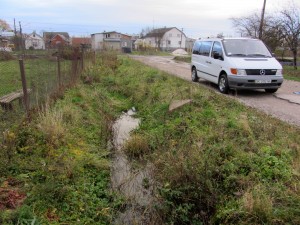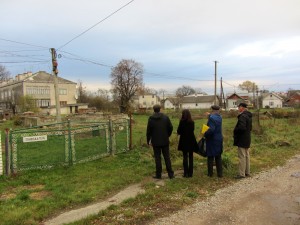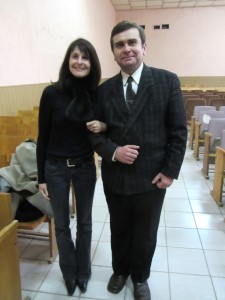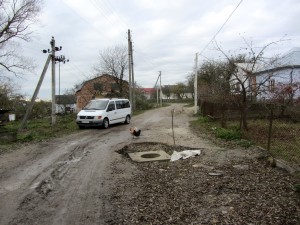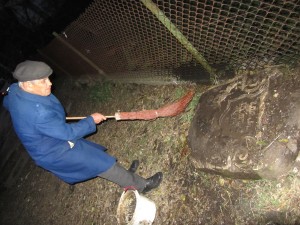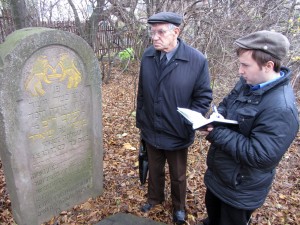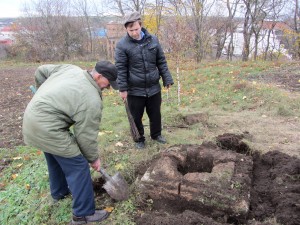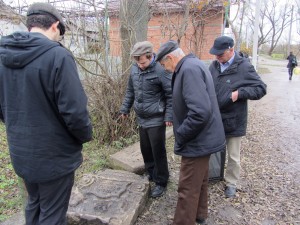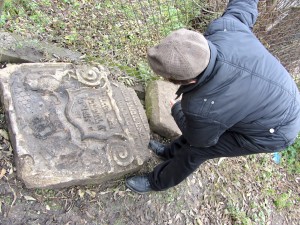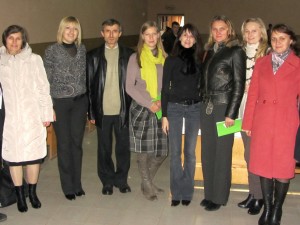As you know, Jay and I made a 2nd 2012 visit to Rohatyn this last week.
We arrived in Lviv at noon on Wednesday November 7 and were greeted by Alex Denysenko and his driver Vitaly, with whom we have traveled on numerous prior occasions. We drove directly from Lviv to Rohatyn and met first with Peace Corps volunteer Abe Lyons at 3:00 p.m. Abe has been tirelessly working as unofficial intermediary in town between our group and Mr. Vorobets, diligently reporting to me when new headstones have been discovered, and for this visit, coordinating the logistics of the lecture I was to be making to students of the Ukrainian high school (time, place, handouts, projector, etc.) on the following day. The five of us (me, Jay, Alex, Vitaly, and Abe) then went to the nearby home of Mr. Vorobets, who was expecting us. We brought small gifts from Paris for both Abe and Mr. Vorobets, a token of our sincere appreciation. As usual, Mr. Vorobets was ready and eager to show us where the latest batch of Jewish headstones had been found. We all boarded Vitaly’s van and headed to the area of town, east and across the river, known as Zavoda. We have been in this area many times before and it has proven rich in headstone discoveries on prior visits (see map link, below, showing headstone locations to-date).
![]() Ця стаття також доступна українською.
Ця стаття також доступна українською.
Our first stop was Zavoda 10A, a corner property owned by the local lawyer Bohdan Skrobach . Turns out that we had never been to this particular part of the Zavoda area, although it is not far from the home of Daria, where in summer 2011 she guided us to see headstones in her neighborhood. On that same visit were group members Alex Feller and Mitchell & Dori Glotzer. Mr. Skrobach’s property is slowly being excavated for construction of a new house. According to Mr. Vorobets (as translated by Alex D), 5 new headstones were recently found here. It is believed that the headstones once paved a pedestrian pathway (likely made during the Nazi occupation) that was then incorporated into the lot when the lot was recently expanded for the anticipated new house construction. Both Mr. Vorobets and Mr. Skrobach anticipate that more headstones will be found as the land is further excavated. The 5 new headstones found at Zavoda 10A have been removed, but we do not believe that they have been moved yet to the new Jewish cemetery. It is more likely that they are loaded onto a cart and awaiting delivery. This means we were unable to shoot photos of them, however.
Of possible good news for our group: Mr. Skrobach is also an historian and has written about the town and its ethnic groups, including Rohatyn’s pre-War Jews. Mr. Skrobach was born in Rohatyn in 1976 and both his parents and grandparents originate in Rohatyn. Mr. Skrobach studied law in Kiev and works in Rohatyn and Lviv. He still lives in the family home; we later met him there and chatted inside Vitaly’s van. Mr. Skrobach spoke of a smaller, second volume to his book that he has written specifically about Rohatyn’s Jews. (At my lecture the next day he presented us with a digital copy of the larger book and a paper copy of the Jewish-specific second volume – really, more in the size of a pamphlet). Mr. Skrobach is looking for help with professional publication of his book, so if there is anyone in the group who would be willing to get involved, we would be more than happy to pass along his contact information. High resolution electronic copies of Mr. Skrobach’s book and the smaller pamphlet he wrote on Rohatyn’s Jews have been given to Alex Feller who will likely post and share these with the group.
Mr. Skrobach was extremely pleased to meet all of us, and we could not help but wonder if he might be an excellent future local connection for our group, as well as a logical “inheritor” to the role that Mr. Vorobets (aged 78) continues to play.
We then traveled by van to the other side of town (east) beyond Babince, to a street where we have been many, many times before: vul. Zelena. This is the street where, on our October 2011 visit – accompanied by the Mayor’s assistant – we walked the roads where the City was planning major water and sewer upgrades in 2012. Some of those upgrades had started by the time of our last visit in May 2012, and as we predicted, headstones are now – 6 months later – being found with each new road section opened; most recently about 14. The Zelena headstone potential is huge and one that I believe will demonstrate the enormity of this project, both in terms of time, manpower, and cost. I am convinced that hundreds of headstones are here.
At present, Mr. Vorobets maintains a working relationship with one of the City’s official excavators; he notifies Mr. Vorobets whenever a headstone is found. Mr. Vorobets then makes a separate arrangement with him for loading and transporting it to the new Jewish cemetery for safekeeping. This is not an insignificant role as it demands this man’s involvement outside his job for the City, on his own time and using his own equipment. Many of the headstones found here to-date have been exceptionally large, requiring several pairs of hands or equipment and machinery. Without “outside” help (meaning, local community involvement), Mr. Vorobets does not feel we can be assured that all headstones being uncovered in the water and sewer upgrade will be recovered and moved by the City administration. (As a side note, while on this street a man approached and mentioned that there had been some headstones here some time ago but that since they have been ground to gravel. This probably occurred before our group was in existence, but it highlights the importance of having someone in town acting on our behalf).
We shot photos of all headstones we found in the road and along driveways that first afternoon, but as it was getting dark, cold, and wet we agreed it was best to return the next day (before my lecture) in daylight. The agreed plan was to meet at 10 a.m. and bring with us Abe and Mr. Vorobets (who cleared his Thursday schedule), as well as Jeremy Borovitz who would be arriving with Abe. We were eager for Jeremy to see all the newly found headstones as well as those already transported to the cemetery, as Jeremy reads Hebrew and speaks Ukrainian – a handy and unique combination! (Jeremy is from New Jersey and his father is a rabbi. Jeremy has been living in western Ukraine as a Peace Corps volunteer for the last couple of years; his mother Ann is already a member of our group. Jeremy has promised to make a report to the group about this visit.)
Later that night at the Elite Hotel in Rohatyn we met and dined with group members (and twin sisters) Chaya Rosen and Deborah Ozair, who came to Rohatyn with Lviv researcher and guide Alexander Dunai. What entertainment! What joy to share a meal together in Rohatyn! Chaya and Deborah – as many of you already know – were in Rohatyn in 1998 when the memorials were erected at the mass graves and at the two cemeteries. They have their own amazing stories of birth and survival (including their family’s hideout in the forest bunkers near Rohatyn), which I hope they will also share with the group. Lots of laughter, tears, and drinking that night!
The next morning, we met with Abe, Jeremy, and Mr. Vorobets, as agreed. Details about the time, place, and logistics of my talk for later that afternoon were fixed. Before returning to Zelena, however, we went to the new Jewish cemetery to take photos and show Jeremy the headstones recovered to-date. Jeremy followed Mr. Vorobets and Alex D., into the far corner of the cemetery behind the trees (now largely without leaves) where a few headstones – made of pink granite – are still standing. Interestingly, as I reported yesterday about my dinner in Krakow Friday night with Ann ROTH, it appears that in 1998 there were more standing stones than today. As the group already knows from my past reports, these stones are quite legible and late in date; plus surnames Teichman and Kirschenbaum, for example, are apparent. On his return to the van, Jeremy announced that all those in the far corner (standing as well as those lying on the ground) belong to Hasidic men. No women.
Jeremy was also able to successfully read several of the headstones placed around the 1998 memorial at the cemetery, including a few surnames and dates. I am hoping that this new information can be appended to the photos of these headstones on the group site, which Alex Feller has organized.
Before concluding on our visit to the cemetery, I would add that the group should seriously think about and discuss a plan for properly identifying and documenting each of the headstones and fragments brought here (a painted number, perhaps?). I regret to say that we can no longer tell what is new because there are too many pieces at this point. Furthermore, the deterioration happening to the earliest stones moved here in 2011 tells me the group also needs to give itself a timeline for planning and implementing a long-term scheme for getting the pieces up off the earth (and probably vertical) to slow the decay. Even if no larger scheme for creating a memorial is decided upon anytime soon, the preservation aspect of this task should not wait past 2013. Time and weather are taking their toll.
Our next stop was “Jerusalem” hill, an area that appears named as such on the 1846 Rohatyn cadastral map. It is adjacent to the “old” Jewish cemetery in the southeast part of town. Jay and I have never known the exact whereabouts of this hill, but Mr. Vorobets guided us there in the van. It is essentially the highest point in the town, just outside the cemetery, located today on a private piece of property. The owner of that property had contacted Mr. Vorobets because he believed he had a Jewish headstone to show us. After a lot of muddy digging – by Abe, Jeremy, Jay, Alex D., and the property owner – what was uncovered was a stone base that most likely at one time had either a cross or other marker on it. Mr. Vorobets explained that the hill – Jerusalem hill – probably got its name because of its proximity to the old Jewish cemetery or because Christian worshipers used to go up and hold services. In any event, the small headstone stacked at the stone base turned out not to be Jewish. (You can see photos of the base and headstone in the link below to our photos).
Our final visit before lunch and my lecture put us back on Zelena. Armed with brooms, brushes, and plastic water bottles – and a lot of stamina – those headstones that we had located and photographed the night before were now cleaned and photographed. In a few cases, new information was revealed and Jeremy got to experience the “ooh” and “aww” that many of us have uncontrollably voiced as mud-encrusted Hebrew letters slowly appeared through the clear, cold creek water dripped over them.
Here we encountered one of the most ornate Jewish headstones that we have seen to-date: lions and a crown. A rabbi according to Jeremy. Such emotion.
Finally, regarding the human bones of 12 individuals that were found earlier this year in the tunnel below the Ukrainian Church, Alex D and I spoke at length to Jeremy about this – Jeremy has a strong religious upbringing (his father, as I mentioned is a rabbi) and is thus in a better position than I to comment on a Jewish re-burial and the requirements of making that happen, if at all. It would be my preference to let Jeremy report to the group on this topic, and he has agreed to follow-up with the priest of the Church and possibly the rabbi of Ivano-Frankivsk, together with Alex D, when he can. We are all in agreement that something soon needs to be done as a matter of human dignity.
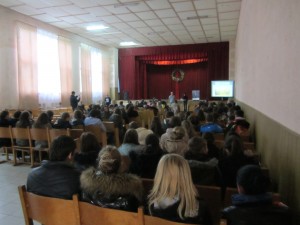
Marla’s lecture at the Rohatyn Ukrainian high school; Alex interpreting to Ukrainian. Photo © 2012 Abe Lyons.
At 2:00 p.m. we arrived at the auditorium of the Ukrainian high school and set up. Projector, screen, and microphone were already ready for me. Students and teachers began to file in; there were about 100 by the time I started at 2:40 p.m. Abe introduced me; Alex D acted as simultaneous translator; Chaya, Deborah, and Jeremy were seated in the first row. Vitaly, Mr. Vorobets, and Mr. Skrobach watched from a few rows back. Jay managed the slides.
I presented about 125 slides, beginning with an introduction about me, my background, and our 2008, 2011, and 2012 visits to the town. I spoke of those who had come before us in 1998. I showed photos of Rohatyn then and now, the faces of our Rohatyn pre-War families (mostly children and young people, which I thought might help the students and young people to better relate to the Jewish tragedy), and my own Horn family. I described our group: who we are, what we do (share photos and stories, research, educate, document, remember), and I emphasized the unique and special circumstances of the present Rohatyn community’s involvement in our projects, including the headstones and the box of Jewish paper scraps found last year. I told them how I had also spoken to students and teachers about Rohatyn in California, Poland, and Paris. I talked about the Nazi occupation of the town, the establishment of the Jewish ghetto, the Shoah in Rohatyn, and the disappearance of an integral part of Rohatyn’s identity: its Jews. I ended in recalling that we – our Jewish families that once lived and thrived here – also called Rohatyn home.
After the talk several students and teachers stayed to talk. Mr. Skrobach also remained. We shot several photos. I gave my contact information to a few teachers and administrators (one teacher promised to email about a student who has written a paper specifically about his research on Rohatyn’s Jewish families) along with several web links, including the Rohatyn webpage on JewishGen which, as you know, has a link to our group. I also gave them the link to the YouTube interview done in summer of 2011 with Alex Feller for local TV. I have already been contacted by 1 student and 1 teacher through Facebook and have added them to the Facebook Rohatyn group.
Finally, as you already know from yesterday’s posting to the group, we ended our short but busy trip spending the night in Krakow at the home of Ania and Witek Stępień, meeting Ann Roth, the mother of Ania and group member Magda; we also had a chance to spend a little time the next morning with group member Piotr Lewicki, who kindly drove us to the airport.
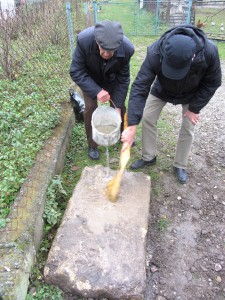
Another headstone reveals its script: Mr. Vorobets and Alex cleaning the stone. Photo © 2012 Jay Osborn.
A special thank you again to Abe (whom we will sorely miss when he leaves Ukraine next month, having completed his Peace Corps service), Jeremy (whom we hope will agree to become our liaison with the Rohatyn community after Abe’s ), and of course Alex Denysenko (our excellent and tireless translator and friend).
Documents and photos from Mr. Vorobets including a recent article he wrote on “Jerusalem Hill” and two class photos (Red School?) with students from 1912 and 1935. There is info Mr. Vorobets has written on the back which you can see and which need translating from Ukrainian:
http://www.pbase.com/nuthatch/
And, as a reminder, here are documents and records received from Mr. Vorobets in 2011:
http://www.pbase.com/nuthatch/
Map showing locations of headstones found to date in Rohatyn:
Close-up photos of headstones moved in 2012 to the new Jewish cemetery:
http://www.pbase.com/nuthatch/
Close up photos of headstones moved in 2011:
http://www.pbase.com/nuthatch/

